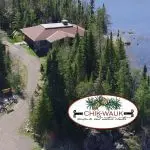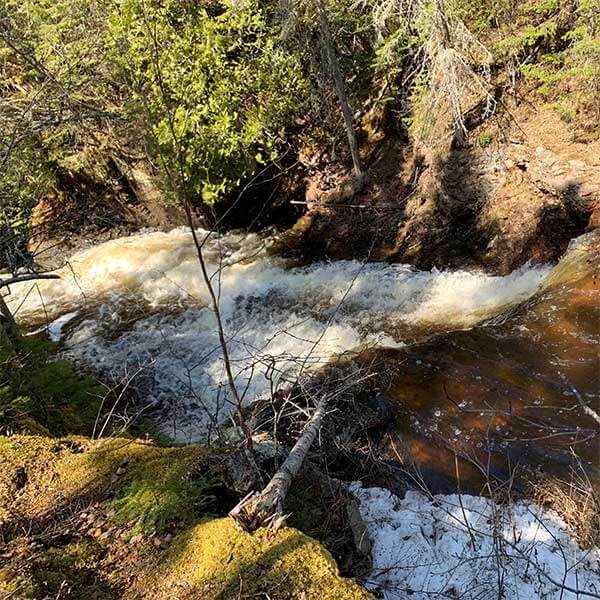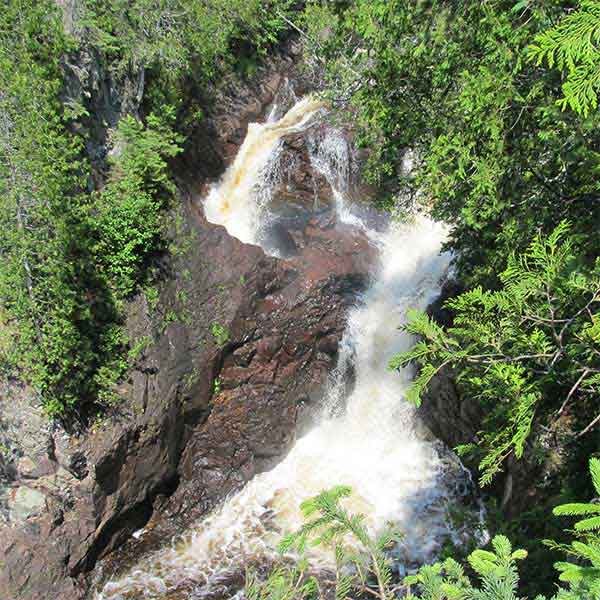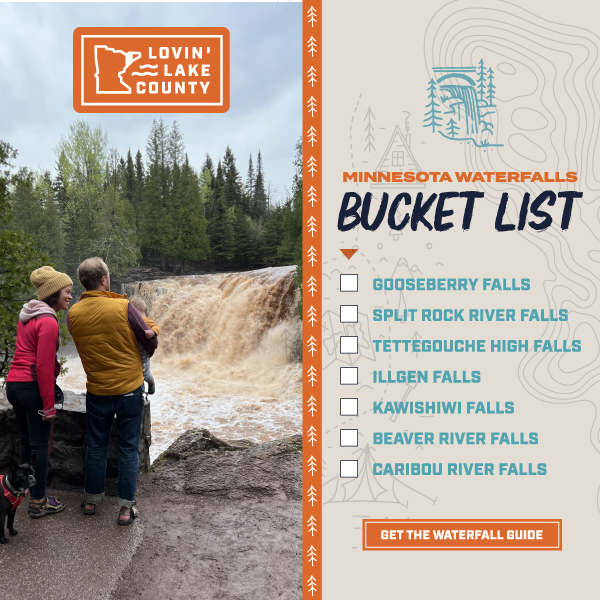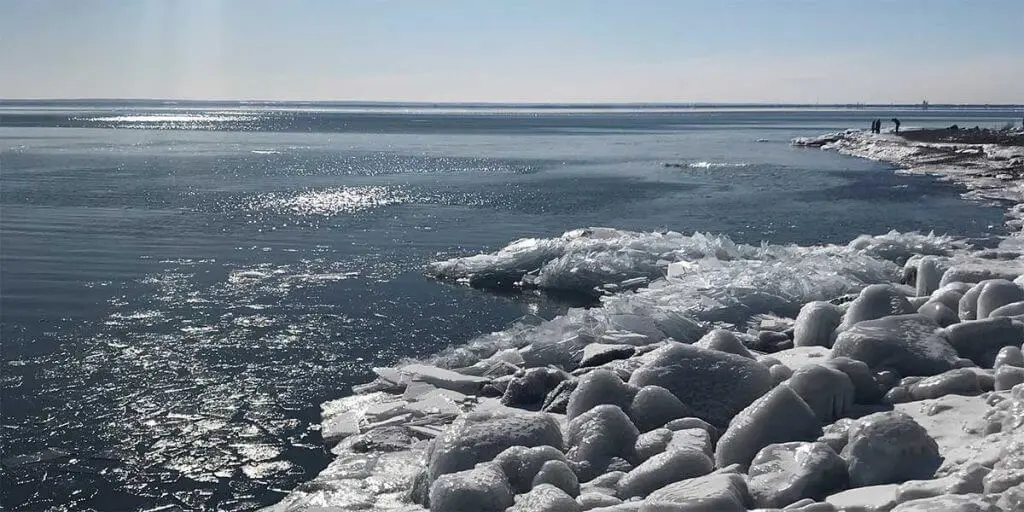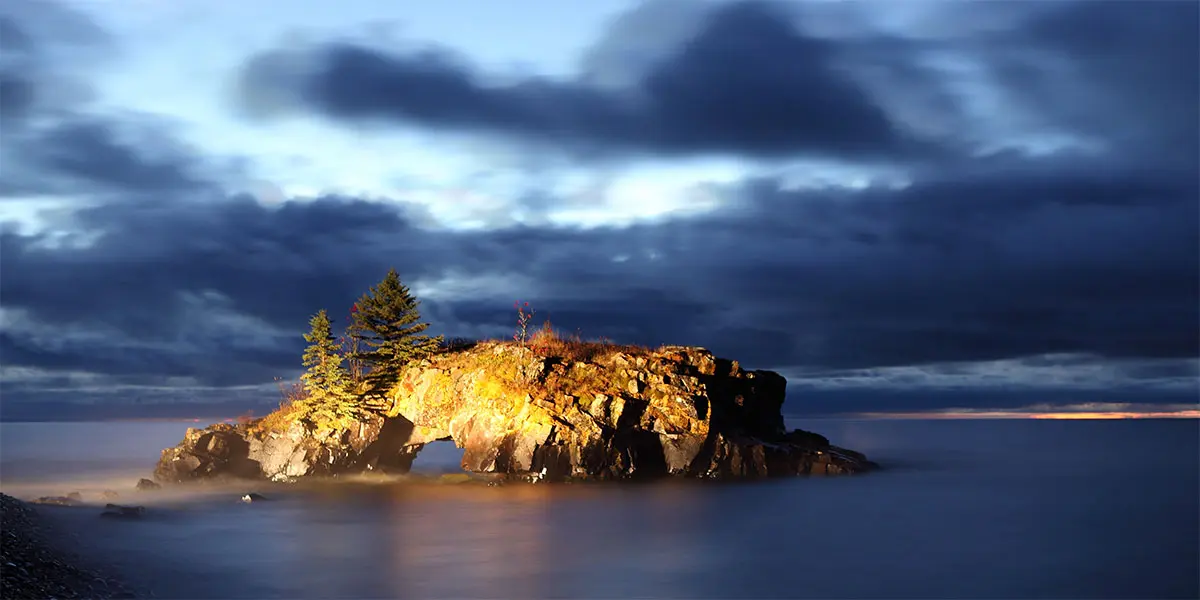
northeast to Grand Portage Area
Northeast of Grand Marais, the road widens, population decreases and the lake shows itself more frequently. It is worth the 41-mile drive just to experience the rugged landscape of this most northeastern tip of Minnesota. Highlands rise to the north, the Susie Islands hover off the coast and Lake Superior gives way to Isle Royale National Park.
The Treaty of 1854 established Grand Portage Reservation and the community continues today. In 1958, Grand Portage was designated a National Monument and in 2007 the Heritage Center was completed as a means to honor the Ojibwe tribe’s history, people and culture’ celebrate this at the Annual Rendezvous Days and PowWow the second full weekend of August.
Mileage starts at the Duluth Lift Bridge
Relax, skip stones, and picnic on the beach. The there-and-back hike follows the Kadunce River with spurs to overlooks and pools. During the warm months of summer, when the water runs low, many locals hike up the river, including climbing the waterfall.
mile 121.0

Icelandite Coastal Fen Scientific and Natural Area
Minnesota’s Newest SNA
MN Scientific and Natural Areas (SNA) protect the last remaining habitat for Minnesota’s rarest plants and animals. Recreation is limited to protect this habitat and natural diversity.
What looks like an unspoiled pebble beach is adjacent to one of only two known existing coastal wetlands on Lake Superior’s north shore known as a fen. A fen is a grassy or shrubby wetland fed by slow moving groundwater with a buildup of peat. Because of the extreme rarity of this wetland type along Lake Superior and its outstanding quality the site was deemed a high priority for protection.
Icelandite is a volcanic rock rich in iron. This rock is a lighter gray than the more abundant dark basalt of the north shore. Icelandite is relatively rare, especially in the Midwest and formed about 1.1 billion years ago.
The Superior Hiking Trail passes through site, which is an Audubon Important Bird Area
The popular hike runs cliffside high above the Brule River. After a spur to the Lower Falls, make the final climb to where the splits. The eastern flow tumbles over the High Falls while the western arm drops into the Devil’s Kettle, final destination unknown. The hike is within Judge C.R. Magney State Park.
mile 126.5

Myhr Creek Ridge Scientific and Natural Area
This remarkable SNA straddles a 4-square mile, east-west oriented ridge of Keweenawan bedrock that rises 439 feet above Lake Superior near Hovland. Droughty conditions on the upper slopes, with patches of exposed bedrock and dry, shallow soils, have historically set the stage for fire. Fires, in turn, have perpetuated these conditions by consuming forest litter that would otherwise contribute to soil development.
Relatively deeper, more organic soils on lower slopes in the northern part of the SNA support less fire-prone communities of aspen-birch forest, wet meadow forest, alder and black ash swamps and a beaver wetland.
Wolves are at home in this landscape, as are many bird species associated with coniferous forest, such as the black-backed woodpecker, red-breasted nuthatch and evening grosbeak. Patches of open bedrock add to the diversity with their native flora of lichens, mosses, poverty grass and sedges.
MN Scientific and Natural Areas (SNA) protect the last remaining habitat for Minnesota’s rarest plants and animals. Recreation is limited to protect this habitat and natural diversity.
mile 128.5 + 3.0 miles

Spring Beauty Northern Hardwoods Scientific and Natural Area
As locals know, for many years the landmark used to find this site was the Hovland Fire Lookout Tower*, an 80′ ladder tower erected in 1931 and removed in summer of 2017. While the fire tower is gone, the old-growth northern hardwood forest thankfully persists.
Visit the SNA—or look at a topographic map—and it’s immediately clear why this site was chosen for a fire tower. From a high plateau, the land falls away steeply on both sides, dropping more than 400 feet in elevation within the boundaries of the SNA. One can look north toward Moosehorn Lake or southeast toward Lake Superior over a densely forested landscape.
MN Scientific and Natural Areas (SNA) protect the last remaining habitat for Minnesota’s rarest plants and animals. Recreation is limited to protect this habitat and natural diversity.
mile 128.6 + 8.0 miles

Hovland Woods Scientific and Natural Area
MN Scientific and Natural Areas (SNA) protect the last remaining habitat for Minnesota’s rarest plants and animals. Recreation is limited to protect this habitat and natural diversity.
This SNA is 1280 acres. Key areas include a 232-acre sugar maple forest, a 180-acre upland white cedar forest, a 44-acre white cedar swamp and a 43-acre lowland white cedar forest. These hardwood forests are able to persist near Lake Superior’s north shore in part because of the lake-moderated climate with cooler summers, milder winters and higher humidity.
The western tract hosts more old-growth and generally more mature forest of all types than the eastern. This is due in large part to their differing fire history: most notably, a 1936 fire that burned 10,000 acres in the central part of the Grand Portage State Forest.
The Superior Hiking Trail passes through site, which is within Grand Portage State Forest. Hike, bird and wildlife watch, snowshoe, and cross-country ski.
WTIP North Shore Community Radio is a listener-supported, non-profit radio station based in Grand Marais, Minnesota, serving the surrounding North Shore area.
WTIP is committed to providing local news, music, and programming that reflects the unique culture and concerns of the region. It plays a vital role in connecting the remote, rural communities along the North Shore, offering a platform for local voices and fostering community engagement.
90.7 FM Grand Marais
90.1 FM Grand Portage
89.1 FM Gunflint Trail
or stream online anytime at https://wtip.org/
Learn about the alliance between the Grand Portage Ojibwe and the North West Company during the fur trade boom in the late 1700s. at the Grand Portage National Monument. Explore the reconstructed stockade and great hall, the visitor center, garden and grounds, Mount Rose trail, and historic Grand Portage trail leading 8.5 miles inland to Fort Charlotte on the Pigeon River.
The Mount Josephine Wayside Rest has a spectacular overlook with views of the Susie Islands below in Lake Superior and Isle Royale in the distance. Isle Royale National Park is part of Michigan. The area is open April through October, has picnic tables and outhouses, and is located on the lake side of Highway 61.
It’s all about hiking to the 120-foot High Falls, but leave time for the exhibits, gift shop and interpretive signs in and around the Visitor Center, where you can learn about the culture and traditions of the Grand Portage Ojibwe people. Bring your camera.
Access to Grand Portage State Park is Free!
State Park Vehicle Permits are NOT required at this park.
Cross the border and spend some time in Canada [passport/approved documentation required to cross the border]. Thunder Bay is 36 miles over the border; along the way are the Middle Falls Provincial Park, shops and farm stands, Old Fort William, and Kakabeka Falls. Canada is English-speaking, uses the same rules of the road, uses the metric system, has their own currency, and is in Eastern Time Zone, one hour ahead of Minnesota.
Northeast to Grand Portage
upcoming events



